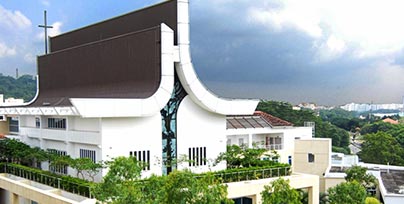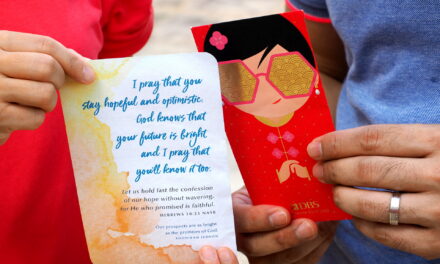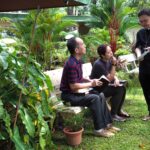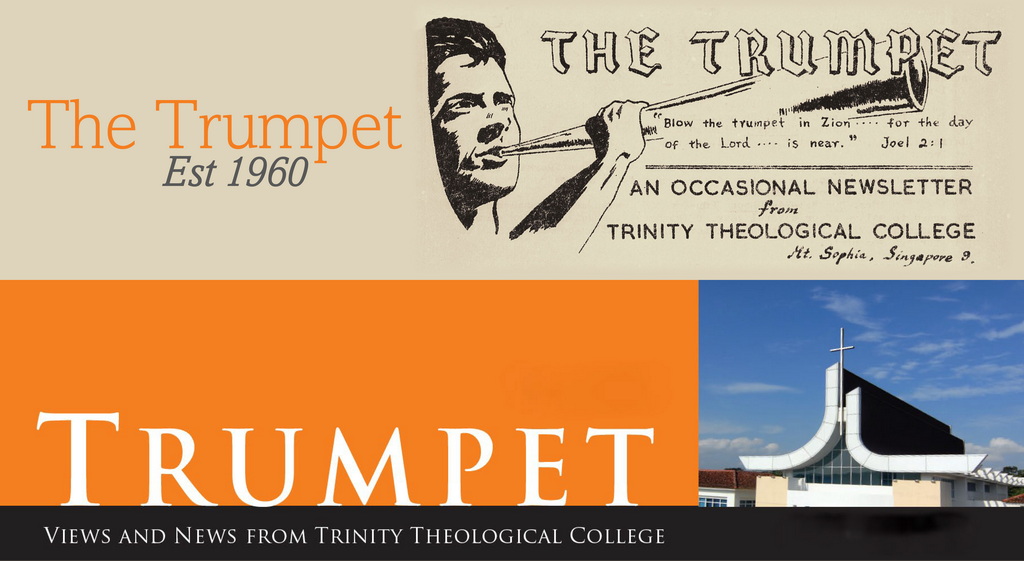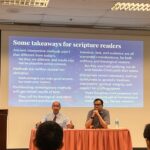
TTC TRUMPET STYLE GUIDE
A style guide is a critical tool for writers, editors, and proofreaders to use for ensuring consistency in the Trumpet. It’s also a good thing for writers, saving their time spent waffling about expression. Our style guide will help to keep everyone on the same page, save time scrolling back to look up details while writing, and can reduce proofreading stress.
The English language is dynamic and ever growing; certainly not lepak (this piece of Singlish is in the OED, okay). So, while we aim to be correct and work to be consistent, we are cognisant that we need to stay aware and be prepared to adapt our use of the language to new norms.
Here are some guidelines to making our Trumpet more consistent.
There are three parts:
1. This style guide itself,
2. A glossary of words and phrases here, and
3. Turabian style abbreviations of the books in the Bible here.
Abbreviations and acronyms
- Cite abbreviations in upper case, eg, WHO (World Health Organization), except for acronyms.
- Capitalise acronyms, ie, abbreviations that are pronounced words, eg, Covid-19.
- No full stop after an abbreviation, eg, etc (for et cetera), unless it occurs at the end of a sentence.
- Write words in their full form on first appearance. After the first mention, use just the abbreviation, eg,
Trinity Theological College (TTC), and after that, TTC.
Books of the Bible
- For a book in the Bible, eg, Hebrews or Matthew, spell out the full name―do not italicise.
- For verses, abbreviate the book according to the Turabian style—click here for the list.
Captions
- For a caption that is a complete sentence, end it with a full stop.
- Omit the full stop for a sentence fragment, eg
The front of the sanctuary
Dr Adam Mano (left) and Dr Ang Meng (right)
Dates
- Use d mmm yyyy for a date, eg, 25 Dec 2022, or
ddd d mmm yyyy, eg, Sun 25 Dec 2022, and
mmm yyyy for a month in a year, eg, Dec 2022. - Avoid date formats like 01 February 2022, 01 Feb 2022, 1 Feb ’22, 1st February 2022, Feb 1st.
Dashes
- Use the en dash as punctuation (no space before or after) between figures to show a range, eg,
1939–45, or
The bak chor mee stall is open 6am–6pm, or
pp 101–108. - Use the em dash (no space before or after) to introduce an explanation, amplification, paraphrase, particularisation or correction of what immediately precedes it. Use it to gather up the subject of a long sentence. Use it to introduce a paradoxical or whimsical ending to a sentence.
- [TIP] To get an en dash –
or em dash —
copy it from here and paste it into your document. Or, get the keyboard shortcuts here.
Denominations and heads of denominations
- Note how these denominations are named. Note too that the definite article “The” with the upper case “T”, not “the”, is a part of some denomination names.
Lutheran Church in Singapore | 新加坡基督教信义会会督
The Diocese of Singapore | 新加坡圣公会教区
The Methodist Church in Singapore | 新加坡卫理公会会督
The Presbyterian Church in Singapore | 基督教新加坡长老会会正 - Note that the honorifics used for the heads of denominations if they are cited with their office may be different from the honorifics used if they are cited without their office:
⁜ ⁜ ⁜ ⁜ ⁜ ⁜ ⁜ - Rt Rev Lu Guan Hoe | 卢元和会督
Bishop, Lutheran Church in Singapore | 新加坡基督教信义会会督
Otherwise, Bishop Lu Guan Hoe or Bishop Lu
⁜ ⁜ ⁜ ⁜ ⁜ ⁜ ⁜ - Most Rev Dr Titus Chung | 章剑文大主教 (博士)
Archbishop, the Province of the Anglican Church in South East Asia | 圣公会东南亚教省大主教
Bishop, The Diocese of Singapore | 新加坡圣公会教区主教
Chairman, Board of Governors | 董事会主席
Otherwise, Archbishop Dr Titus Chung or Archbishop Dr Chung
⁜ ⁜ ⁜ ⁜ ⁜ ⁜ ⁜ - Rev Dr Gordon Wong | 黄昌荣会督 (博士)
Bishop, The Methodist Church in Singapore | 新加坡卫理公会会督
Otherwise, Bishop Dr Gordon Wong or Bishop Dr Wong
⁜ ⁜ ⁜ ⁜ ⁜ ⁜ ⁜
Rt Rev Dr Christopher Chia | 谢家添牧师 (博士)
Moderator, The Presbyterian Church in Singapore | 基督教新加坡长老会会正
Otherwise, Rt Rev Dr Christopher Chia or Rt Rev Dr Chia
⁜ ⁜ ⁜ ⁜ ⁜ ⁜ ⁜
Bishop Emeritus Dr Robert Solomon on the first mention, subsequently, BE Dr Robert Solomon or BE Dr Solomon
Bishop Emeritus Dr Chong Chin Chung on the first mention, subsequently, BE Dr Chong Chin Chung or BE Dr Chong
⁜ ⁜ ⁜ ⁜ ⁜ ⁜ ⁜
Ellipsis…
- When you use ellipses (no space before or after) in omissions from speech or writing of a word or words that are superfluous, add a full stop at end after an ellipsis if it is for a complete sentence, eg, ….
Emphasis
- Use italics alone for emphasis. Do not use bold or underlining or a combination of these formats.
Eg, We should oppose such a development with any legal means possible.
Footnotes
- Avoid footnotes for more fluent reading. Incorporate all necessary information into the body of your article.
Greek and Hebrew
- Transliterate and italicise Greek and Hebrew words. Also italicise words in other non-English languages, eg, German, French and Latin.
Obliques or slashes
- Except in fractions, avoid using this between alternatives, eg,
and/or
still/sparkling/tap. - Pick either and or or, and write lists the usual way, eg,
still, sparkling or tap.
Names, honorifics, and abbreviations
- No full stops, eg,
Rev Dr Edwin Tay, not Rev. Dr. Edwin Tay
DTh, not D. Th
PhD, not Ph. D
Mr Mistoffelees, not Mr. Mistoffelees. - Cite a current student’s name like this: Mr Gilbert Lok, MDiv 3.
- Cite an alumnus’ name like this: Ps Daniel Lee Kong Leong (BD 2015).
Numbers
- Spell out whole number words for one to ten; use figures for numbers above ten.
Numbering in articles
- Should you need to number questions, main points, etc in your article, choose a simple, clean 1. 2. 3.
- Consider using bullets to list as an alternative to numbers.
Pull quotes
- There’s no need to enclose your suggested pull quote in quotation marks.
- Should you choose to start your pull quote mid-sentence, use an ellipsis (…) with no space before your quote.
- Should you end your pull quote mid-sentence, end with an ellipsis.
Punctuation
- No space before and just one space after punctuation marks except for dashes (no space before or after).
- Abhor double spaces after a full stop–respect the design of the typographer.
Quotation marks
- Use double quotation marks, eg, for direct speech, quotes, Bible verses, poems, names of articles, names of short stories, chapter titles, or to highlight a word or phrase.
- Use single quotation marks for a quote within a quote.
Eg, “When I say ‘immediately,’ I mean some time before August,” said the manager. - Place the comma or full stop outside the quotation marks for incomplete sentences, phrases and words. But if it’s for the end of a complete sentence, put the full stop inside quotation marks.
- Prefer the typographer’s or curly apostrophe (’) and quotes (‘’ “”) over straight or vertical quotes which are a legacy from the days of typewriters. They just look smarter and more professional.
References to God and Jesus
- No capitalisation for the pronouns of God and Jesus, eg,
God has always used people for the advancement of his kingdom. - For the possessive of Jesus, a single apostrophe is suggested, as in:
King Herod heard of it, for Jesus’ name had become known. Some said, “John the Baptist has been raised from the dead. That is why these miraculous powers are at work in him.
Mark 6:14 (ESV)
Spelling
- We prefer British spelling. Use as a reference, the Oxford Dictionary. Pick the English spelling, not the American English one.
- The exception to this rule is what are direct quotations or titles. For these, use the exact words.
Subheads and article titles
- Do suggest subheads for your article if it is long.
- Instead of putting a subhead or your article title in all upper case or in sentence case, consider title case, ie, capitalising it as you would a hymn, eg, Christ the Lord is Risen Today.
- Here is a title case reference and one from Wikipedia.
Time
- Use a full stop instead of a colon with no space before am and pm, eg,
8am, 6.30pm. - For a time range, use the en dash (no space before or after), eg,
11.30am–3.30pm,
11am–noon, or
10am–2pm. - If it’s eight o’clock at night, write it as just 8am.
Leave out the minutes unless they are part of a range where the minutes are needed, eg,
11.00am–3.30pm. - Avoid these formats: 7:30 – 9pm; 1300pm; 1800 hours
- For neatness, if it is just one mention in your article, match the minutes in the period, eg, 2pm–3pm, 2.30pm-3.00pm, otherwise, use h.mm
- Note that it is just noon or midnight, not 12pm or 12am, eg, 10am to noon, 10pm to midnight.
Titles of books, magazines, etc
- Put the titles of books, magazines and newspapers in italics, eg, The Economist, The Straits Times (note that the article is part of the names of these publications).
- Titles of books that form a larger body of work may be put in quotation marks if the name of the book series is italicised.
- In general, italicise the titles of long works, such as books, movies, or record albums.
- Use double quotation marks for the titles of shorter pieces of work: poems, articles, book chapters, songs, and TV shows.
- Cite just the author’s name and, in italics, the title. There is no need to add the year unless it is essential for clarity.
eg, Jerome Karabel’s The Chosen;
James Oldfield mentions in his article “Just Theology” that… - Don’t italicise long quotations. Indent if appropriate.
Trinity Theological College
- What do we call ourselves? Between a school and a college, pick college. No caps.
Cite in full in the first instance, then use TTC.
updated 240409
